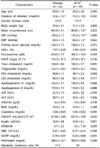1. Alberti KG, Zimmet P, Shaw J. IDF Epidemiology Task Force Consensus Group. The metabolic syndrome--a new worldwide definition. Lancet. 2005; 366:1059–1062.

2. Expert Panel on Detection, Evaluation, and Treatment of High Blood Cholesterol in Adults. Executive summary of the third report of the National Cholesterol Education Program (NCEP) Expert Panel on Detection, Evaluation, and Treatment of High Blood Cholesterol in Adults (Adult Treatment Panel III). JAMA. 2001; 285:2486–2497.
3. World Health Organization. Global Health Risks: Mortality and Burden of Disease Attributable to Selected Major Risks. Geneva: World Health Organization;2009.
4. Je JY, Park JY, Jung WK, Park PJ, Kim SK. Isolation of angiotensin I converting enzyme (ACE) inhibitor from fermented oyster sauce,
Crassostrea gigas. Food Chem. 2005; 90:809–814.

5. Unger T. The role of the renin-angiotensin system in the development of cardiovascular disease. Am J Cardiol. 2002; 89:3A–9A.

6. Lee JK, Hong S, Jeon JK, Kim SK, Byun HG. Purification and characterization of angiotensin I converting enzyme inhibitory peptides from the rotifer,
Brachionus rotundiformis. Bioresour Technol. 2009; 100:5255–5259.

7. Lapointe N, Rouleau JL. Activation of vascular tissue angiotensin-converting enzyme (ACE) in heart failure. Effects of ACE inhibitors. J Am Coll Cardiol. 2002; 39:776–779.

8. Rossi S, editor. Australian Medicines Handbook 2006. Adelaide: Australian Medicines Handbook;2006.
9. Sidorenkov G, Navis G. Safety of ACE inhibitor therapies in patients with chronic kidney disease. Expert Opin Drug Saf. 2014; 13:1383–1395.

10. Ko SC, Kim DG, Han CH, Lee YJ, Lee JK, Byun HG, Lee SC, Park SJ, Lee DH, Jeon YJ. Nitric oxide-mediated vasorelaxation effects of anti-angiotensin I-converting enzyme (ACE) peptide from
Styela clava flesh tissue and its anti-hypertensive effect in spontaneously hypertensive rats. Food Chem. 2012; 134:1141–1145.

11. Ko SC, Lee JK, Byun HG, Lee SC, Jeon YJ. Purification and characterization of angiotensin I-converting enzyme inhibitory peptide from enzymatic hydrolysates of
Styela clava flesh tissue. Process Biochem. 2012; 47:34–40.

12. Matthews DR, Hosker JP, Rudenski AS, Naylor BA, Treacher DF, Turner RC. Homeostasis model assessment: insulin resistance and beta-cell function from fasting plasma glucose and insulin concentrations in man. Diabetologia. 1985; 28:412–419.

13. Lee JK, Jeon JK, Byun HG. Antihypertensive effect of novel angiotensin I converting enzyme inhibitory peptide from chum salmon (
Oncorhynchus keta) skin in spontaneously hypertensive rats. J Funct Foods. 2014; 7:381–389.

14. Ko SC, Jung WK, Kang SM, Lee SH, Kang MC, Heo SJ, Kang KH, Kim YT, Park SJ, Jeong Y, Kim M, Byun HG, Jeon YJ. Angiotensin I-converting enzyme (ACE) inhibition and nitric oxide (NO)-mediated antihypertensive effect of octaphlorethol A isolated from
Ishige sinicola: in vitro molecular mechanism and in vivo SHR model. J Funct Foods. 2015; 18:289–299.

15. Ko SC, Lee M, Lee JH, Lee SH, Lim Y, Jeon YJ. Dieckol, a phlorotannin isolated from a brown seaweed,
Ecklonia cava, inhibits adipogenesis through AMP-activated protein kinase (AMPK) activation in 3T3-L1 preadipocytes. Environ Toxicol Pharmacol. 2013; 36:1253–1260.

16. Lee SH, Jeon YJ. Efficacy and safety of a dieckol-rich extract (AG-dieckol) of brown algae,
Ecklonia cava, in pre-diabetic individuals: a double-blind, randomized, placebo-controlled clinical trial. Food Funct. 2015; 6:853–858.

17. Lee SH, Kang SM, Ko SC, Moon SH, Jeon BT, Lee DH, Jeon YJ. Octaphlorethol A: a potent α-glucosidase inhibitor isolated from
Ishige foliacea shows an anti-hyperglycemic effect in mice with streptozotocin-induced diabetes. Food Funct. 2014; 5:2602–2608.

18. Jung ES, Park EJ, Park HR, Lee SC. Antioxidant activities of extracts from parts of Styela clava. J Korean Soc Food Sci Nutr. 2008; 37:1674–1678.
19. Kang N, Ko SC, Samarakoon K, Kim EA, Kang MC, Lee SC, Kim J, Kim YT, Kim JS, Kim H, Jeon YJ. Purification of antioxidative peptide from peptic hydrolysates of Mideodeok (
Styela clava) flesh tissue. Food Sci Biotechnol. 2013; 22:541–547.

20. Chung BH, Kim S, Kim JD, Lee JJ, Baek YY, Jeoung D, Lee H, Choe J, Ha KS, Won MH, Kwon YG, Kim YM. Syringaresinol causes vasorelaxation by elevating nitric oxide production through the phosphorylation and dimerization of endothelial nitric oxide synthase. Exp Mol Med. 2012; 44:191–201.

21. Ondetti MA, Cushman DW. Enzymes of the renin-angiotensin system and their inhibitors. Annu Rev Biochem. 1982; 51:283–308.

22. Kamiya A, Ando J, Shibata M, Masuda H. Roles of fluid shear stress in physiological regulation of vascular structure and function. Biorheology. 1988; 25:271–278.

23. Ko SC, Kim JI, Park SJ, Jung WK, Jeon YJ. Antihypertensive peptide purified from
Styela clava flesh tissue stimulates glucose uptake through AMP-activated protein kinase (AMPK) activation in skeletal muscle cells. Eur Food Res Technol. 2016; 242:163–170.

24. Henriksen EJ, Jacob S. Modulation of metabolic control by angiotensin converting enzyme (ACE) inhibition. J Cell Physiol. 2003; 196:171–179.

25. Toda N, Arakawa K. Salt-induced hemodynamic regulation mediated by nitric oxide. J Hypertens. 2011; 29:415–424.









 PDF
PDF ePub
ePub Citation
Citation Print
Print



 XML Download
XML Download